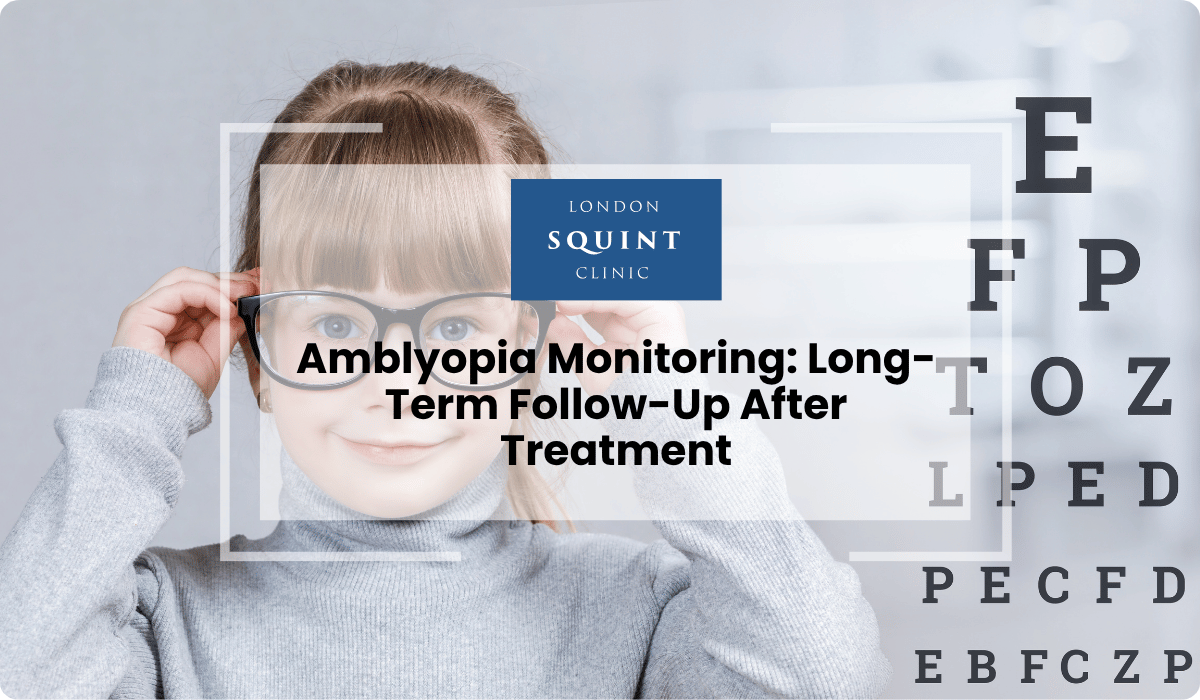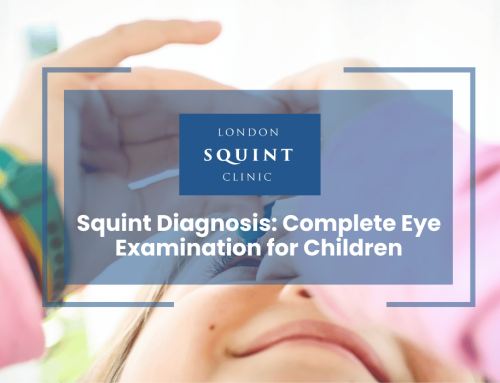Amblyopia Monitoring: Long-Term Follow-Up After Treatment
Essential Insights for Parents: Protecting Your Child’s Vision Journey
- Approximately 25% of successfully treated amblyopia cases may experience regression without proper monitoring, making long-term follow-up care essential for preserving vision gains.
- The most critical monitoring periods occur immediately after treatment ends (0-6 months), during growth spurts (ages 4-7), and during school transitions when visual demands increase.
- Follow-up appointments typically follow a tapering schedule: monthly checks for the first 3 months, gradually decreasing to annual visits after 5 years post-treatment.
- Parents should watch for warning signs between appointments, including eye misalignment, reading difficulties, depth perception issues, and returning to old visual habits like squinting or head tilting.
- Monitoring can safely conclude when visual acuity remains stable for 1-2 years, binocular function is established, and the child has completed critical visual development (typically by age 10-12).
- Supporting activities between appointments—including consistent glasses wear, visual-motor activities, balanced screen time, and outdoor play—help reinforce treatment gains and reduce regression risk.
Table of Contents
- Understanding Amblyopia: Why Long-Term Monitoring Matters
- Critical Periods: When Follow-Up Care Is Most Essential
- How Often Should Children Have Post-Amblyopia Check-Ups?
- Signs of Amblyopia Recurrence Parents Should Watch For
- Monitoring Techniques Used by Pediatric Ophthalmologists
- When Can Long-Term Amblyopia Monitoring Safely End?
- Supporting Visual Development Beyond Clinical Follow-Ups
Understanding Amblyopia: Why Long-Term Monitoring Matters
Amblyopia, commonly known as lazy eye, affects approximately 3% of children in the UK and requires diligent treatment and follow-up care. This condition develops when the brain favours one eye over the other, leading to reduced vision in the weaker eye. While initial treatments such as patching, atropine drops, or vision therapy can be highly effective, the journey doesn’t end once treatment concludes.
Long-term amblyopia monitoring is crucial because this condition can recur, particularly during periods of visual development. The brain’s neuroplasticity—its ability to form new neural connections—means that vision improvements can either solidify or regress over time. Studies show that approximately 25% of successfully treated children may experience some degree of regression if monitoring and maintenance therapy are discontinued too early.
The stakes are particularly high with amblyopia because untreated or recurring cases can lead to permanent vision deficits, affecting depth perception, reading ability, and potentially limiting future career options. Consistent post-treatment monitoring ensures that any regression is caught early when intervention can still be effective. This vigilance protects the significant investment of time and effort that families have already committed to the initial treatment phase.
Critical Periods: When Follow-Up Care Is Most Essential
The concept of critical periods is fundamental to understanding amblyopia monitoring. The visual system develops most rapidly from birth to approximately age 8, with the first few years being particularly crucial. During this time, the brain remains highly responsive to visual input and correction, making it the optimal window for both treatment and follow-up care.
The most intensive monitoring is typically required during these key developmental stages:
- Immediately post-treatment (0-6 months): This period carries the highest risk of regression as the brain adjusts to using both eyes equally without the assistance of patching or other interventions.
- Growth spurts (ages 4-7): Rapid physical development can sometimes coincide with changes in visual function, requiring careful observation.
- School transitions (ages 5-7): The increased visual demands of reading and close work may reveal subtle visual deficits that weren’t apparent before.
- Pre-adolescence (ages 8-12): While the critical period is closing, some children still benefit from monitoring as their visual system finalises its development.
Research indicates that the brain retains some plasticity beyond these traditional critical periods, particularly in cases where amblyopia treatment was initiated early. This understanding has led to more nuanced approaches to long-term monitoring, with some specialists recommending periodic assessments even into the teenage years for children who experienced severe amblyopia.
How Often Should Children Have Post-Amblyopia Check-Ups?
The frequency of post-amblyopia follow-up appointments follows a generally tapering schedule, though this is always personalised based on the child’s specific condition, treatment response, and risk factors. A typical monitoring schedule might look like this:
- First 3 months post-treatment: Monthly check-ups to ensure stability of visual gains
- 3-12 months post-treatment: Bi-monthly or quarterly assessments
- 1-2 years post-treatment: Every 4-6 months
- 2-5 years post-treatment: Every 6-12 months
- Beyond 5 years: Annual check-ups until the ophthalmologist determines monitoring can safely end
This schedule may be intensified for children with certain risk factors, including:
- History of poor compliance with initial treatment
- Severe initial amblyopia (visual acuity worse than 6/18)
- Associated strabismus (squint) that required surgical correction
- Significant refractive errors requiring regular prescription updates
- Family history of persistent or recurrent amblyopia
It’s worth noting that different treatment approaches for amblyopia may also influence the monitoring schedule. Children who underwent vision therapy might benefit from different follow-up protocols compared to those who primarily used patching, as the mechanisms of visual improvement differ slightly between these approaches.
Signs of Amblyopia Recurrence Parents Should Watch For
Parents play a crucial role in the long-term monitoring of amblyopia, as they can often notice subtle changes in their child’s visual behaviour between clinical appointments. Being vigilant about the following signs can help catch potential regression early:
- Returning to old visual habits: Closing or covering one eye when focusing, tilting the head, or squinting
- Complaints about vision: Comments about blurriness, double vision, or difficulty seeing distant objects
- Reading difficulties: Losing place when reading, avoiding reading, or holding books unusually close
- Depth perception issues: Trouble with catching balls, pouring liquids, or navigating stairs
- Eye alignment changes: Any noticeable drift or misalignment of the eyes, even if intermittent
- Headaches or eye strain: Particularly after visual tasks like reading or screen time
- Decreased academic performance: Especially in visually demanding subjects
If parents observe any of these signs, they should not wait until the next scheduled appointment but contact their pediatric ophthalmologist promptly. Early intervention during a regression can often prevent the need for returning to intensive treatment protocols. Some specialists recommend that parents conduct simple at-home vision checks between appointments, such as having the child read from a book or distant sign with each eye separately, though these should never replace professional assessment.
Monitoring Techniques Used by Pediatric Ophthalmologists
Pediatric ophthalmologists employ a range of sophisticated techniques to monitor amblyopia recovery and detect any signs of regression. These assessments are designed to be child-friendly while providing precise measurements of visual function:
- Visual acuity testing: Age-appropriate methods such as picture charts for younger children and letter charts for older ones. The gold standard for monitoring is comparing the vision between the previously amblyopic eye and the dominant eye.
- Contrast sensitivity testing: Measures the ability to distinguish between subtle differences in shading, which can reveal functional deficits even when standard acuity appears normal.
- Stereopsis assessment: Tests for depth perception using specialised 3D images, as binocular vision is often the last function to fully recover.
- Ocular alignment measurements: Precise measurements of eye alignment using prism bars or computerised systems to detect subtle changes that might precede visual regression.
- Refraction assessment: Regular checks for changes in prescription that might affect the balance between the eyes.
- Fundus examination: Evaluation of the retina and optic nerve to ensure there are no structural changes affecting vision.
More advanced monitoring may include:
- Visual evoked potentials (VEPs): Measures the electrical activity in the visual cortex when visual stimuli are presented.
- Optical coherence tomography (OCT): Provides detailed images of retinal structure, which can sometimes show subtle changes in cases of amblyopia.
- Eye tracking technology: Analyses eye movement patterns that might indicate visual processing difficulties.
These comprehensive assessments allow specialists to detect even minor changes in visual function that might indicate the beginning of regression, enabling prompt intervention before significant vision loss occurs.
When Can Long-Term Amblyopia Monitoring Safely End?
The decision to conclude amblyopia monitoring is individualised and based on multiple factors rather than simply reaching a certain age. Most pediatric ophthalmologists consider several key criteria before determining that formal monitoring can safely end:
- Stable visual acuity: The previously amblyopic eye has maintained equal or nearly equal vision compared to the dominant eye for at least 1-2 years without any intervention.
- Completed visual development: The child has passed through the critical periods of visual development, typically by age 10-12.
- Established binocular function: The child demonstrates good stereopsis (3D vision) and the eyes work together effectively.
- Stable refractive error: The child’s prescription has remained consistent for several consecutive visits.
- No risk factors for regression: Absence of strabismus, significant refractive differences between eyes, or family history of persistent amblyopia.
Even after formal monitoring ends, many specialists recommend:
- Continuing routine eye examinations every 1-2 years throughout adolescence
- Promptly seeking assessment if any visual symptoms develop
- Special attention during times of hormonal changes (puberty) which can occasionally affect vision
It’s important to note that while the intensive monitoring phase may conclude, awareness of the child’s visual history should continue into adulthood. Adults with a history of childhood amblyopia should inform eye care providers of this background, as it may influence future eye care decisions and monitoring needs, particularly if other eye conditions develop later in life.
Supporting Visual Development Beyond Clinical Follow-Ups
While clinical monitoring forms the backbone of post-amblyopia care, parents can take numerous steps to support optimal visual development between appointments. These complementary approaches help reinforce treatment gains and potentially reduce the risk of regression:
- Maintaining consistent glasses wear: If prescribed, ensuring glasses are worn as directed, even after the active treatment phase has ended.
- Encouraging visual-motor activities: Activities like drawing, building with blocks, ball games, and puzzles all help strengthen the visual system and eye-hand coordination.
- Balanced screen time: Limiting excessive screen exposure and ensuring appropriate viewing distances and lighting conditions.
- Reading practice: Regular reading helps maintain visual focus and processing skills. For younger children, shared reading with parents provides both visual and cognitive benefits.
- Outdoor time: Research suggests that spending time outdoors may benefit overall eye development and help prevent myopia progression.
- Nutrition: A balanced diet rich in omega-3 fatty acids, vitamins A, C, E, and zinc supports overall eye health.
Some families also find value in periodic “maintenance exercises” recommended by their vision specialists. These might include:
- Brief periods of patching during visually demanding activities
- Home-based vision therapy exercises to maintain binocular skills
- Games specifically designed to challenge and strengthen the visual system
Equally important is maintaining open communication with teachers about the child’s visual history. Educators can help by positioning the child optimally in the classroom, being alert to signs of visual fatigue, and adjusting assignments if necessary. This collaborative approach between healthcare providers, parents, and educators creates a supportive environment for sustained visual development long after the initial treatment phase has concluded.
Frequently Asked Questions
How long does amblyopia monitoring typically continue after treatment?
Amblyopia monitoring typically continues for at least 2-5 years after active treatment ends. The schedule gradually tapers from monthly checks immediately post-treatment to annual visits after several years of stability. Monitoring may extend into adolescence for children who had severe amblyopia or additional risk factors. The decision to end monitoring is based on sustained visual stability, completed visual development (usually by age 10-12), established binocular function, and stable refractive error.
What percentage of children experience amblyopia recurrence after successful treatment?
Approximately 25% of successfully treated children may experience some degree of amblyopia regression if monitoring and maintenance therapy are discontinued too early. Recurrence risk is higher in children with severe initial amblyopia (visual acuity worse than 6/18), associated strabismus, significant refractive errors, or a family history of persistent amblyopia. Consistent follow-up care significantly reduces this recurrence rate by enabling early intervention at the first signs of regression.
Can amblyopia return after the critical period of visual development?
While amblyopia is less likely to return after the critical period (approximately age 8), some risk of regression remains until visual development is complete around age 10-12. The brain retains some plasticity beyond traditional critical periods, particularly in cases where treatment was initiated early. This is why monitoring often continues into pre-adolescence, with some specialists recommending periodic assessments even into the teenage years for children who experienced severe amblyopia.
What should parents do if they notice signs of amblyopia recurrence between appointments?
If parents notice signs of amblyopia recurrence—such as eye misalignment, covering one eye when focusing, complaints about blurry vision, reading difficulties, or depth perception issues—they should contact their pediatric ophthalmologist immediately rather than waiting for the next scheduled appointment. Early intervention during regression can often prevent the need to restart intensive treatment protocols. Parents should not attempt to resume patching or other treatments without professional guidance.
Are there home exercises that can help prevent amblyopia recurrence?
Some beneficial home activities to support amblyopia treatment gains include:
1. Visual-motor activities like drawing, building with blocks, and ball games
2. Regular reading practice with appropriate lighting and posture
3. Brief periods of prescribed maintenance patching during visually demanding activities (if recommended by your specialist)
4. Specific vision therapy exercises provided by your eye care professional
5. Digital vision therapy apps approved by your ophthalmologist
These activities should complement, not replace, professional monitoring and should only be done under the guidance of your eye care provider.
How do school activities affect amblyopia monitoring and management?
School activities significantly impact amblyopia management as increased visual demands (reading, board work, computer use) can reveal subtle visual deficits or trigger regression. School transitions (ages 5-7) are considered critical periods for monitoring. Parents should inform teachers about their child’s condition, ensure proper classroom positioning, monitor for signs of visual fatigue during academic work, and schedule follow-up appointments around school transitions. Academic performance changes, particularly in visually demanding subjects, can sometimes indicate amblyopia recurrence.
Does having amblyopia as a child affect vision in adulthood?
Successfully treated amblyopia with proper long-term monitoring typically results in stable, good vision throughout adulthood. However, adults with a history of childhood amblyopia should inform all future eye care providers about this background, as they may have slightly higher risks for certain eye conditions and may benefit from more vigilant monitoring. Without proper treatment and follow-up care, childhood amblyopia can lead to permanent vision deficits affecting depth perception, reading ability, and potentially limiting certain career options that require excellent binocular vision.
Find out if you are suitable for Double Vision Treatment
Not everyone is eligible for double vision surgery.
Find out if you could benefit from this life-changing surgery by taking the quick self-suitability quiz below:
Our most popular procedures

Hello, I’m Nadeem Ali
I’m one of the few eye surgeons in the world with 100% focus on Squint and Double Vision Surgery.
I have 24 years of eye surgery experience, and worked for 13 years as a Consultant at London’s renowned Moorfields Eye Hospital.
In 2023, I left the NHS to focus fully on treating patients from across the world at the London Squint Clinic. You can read more about me here.
There’s lots of information on the website about: squint surgery, double vision surgery and our pricing.
The most rewarding part of my job is hearing patients tell me how squint or double vision surgery has changed their lives. You can hear these stories here.
Mr Nadeem Ali
MA MB BChir MRCOphth FRCSEd(Ophth)





